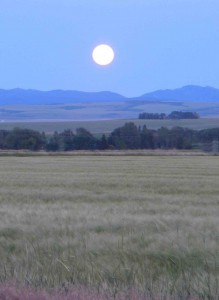Gluten: the Tooth of the Matter

Gluten-what is it, really?
I love the grain field next to my house. I love to watch it grow and turn colors. My favorite time of the year is when it is almost ready to turn colors. The green stalks will move in the breeze and look just like the waves on the ocean. It is beautiful.
Wheat is beautiful. It has been a life-saving grain for mankind for centuries because it can be stored. However, I have found that, for me, it isn't the greatest thing. Why? What is "gluten" anyway? Gluten is a protein found in wheat and barley composed of two parts...glutenin and gliaden. Gliaden is the culprit for most of the problems created by wheat, although not all! To help us understand the current impact of gliaden and wheat, we must understand its history.
In 1943, a world-wide effort began to increase yields of corn, soy and wheat to help starving under-privileged countries. They did this in part, by using hybridization. Thousands of new strains of wheat were being produced by 1980. These new strains were more hardy against weather, diseases, and increased yield by 10%.
More than 99% of wheat crops are now “dwarfed,” growing to 18” tall instead of 4 1/2 feet. No animal or human safety testing have been conducted on these new strains of soy, corn, or wheat. In one study, fourteen new gluten proteins were identified in the new hybridized wheat. I am thankful we are able to feed more people. I worry, however about the impact all of these changes have made?
What are some of the things we currently know about gluten?
- Autoimmune disease has increased exponentially since the 1960's. Celiac disease is an autoimmune disease where the body attacks its own intestinal cells, causing symptoms in the intestine and throughout the body. It's incidence is increasing, and is the only known autoimmune disease which we know how to treat...the treatment is to avoid gluten.*
- Leptin is a protein signal your body uses to tell itself it is full, and to inhibit appetite. Researchers currently speculate that gluten blocks the leptin receptors, so leptin cannot act to inhibit appetite and the brain does not feel satiated. Gliaden induces the release of Zonulin (a protein signal in the intestine), which opens channels between intestinal cells, causing and increase in intestinal permeability. (You can read more about this on my Digestion and GI Health page)*
- Gliaden is the only protein we eat that we cannot fully break down.*
Gluten isn't the only problem with hybridized wheat. Here are a few other facts about wheat:
- The carbohydrate in wheat is more rapidly absorbed than sugar. This increases insulin substantially and rapidly. This effect, occurring over and over, can cause fat accumulation in the abdomen known as visceral fat.*
- Wheat changes the bacteria in your intestines. Try a wheat-free diet accompanied by high potency probiotics and fiber to improve overall health.*
- The outside coating of wheat is called lectin. Because of the hybridization and engineering to make the lectin more resistant, it is also directly irritating to many peoples intestines.*
Dr. William Davis writes a book called Wheat Belly. He sees the following things in his patients when they go off wheat and other grains:*
- Weight loss- 18 lbs typical
- Reduced appetite and food obsession
- Blood sugar reduction
- Reduced joint pain--especially fingers and wrists
- Reduced c-reactive protein
- Reduced blood pressure
- Reduced triglycerides, small LDL (bad cholesterol) and increased HDL (good cholesterol)
- Increased energy and improved sleep
- Less acid reflux and a 90% reduction in irritable bowel symptoms.
- Wheat withdrawal- fatigue, headache, increase appetite for 5 days.
Sounds like a pretty amazing boost to your health to me. Just give it a try. Just 30 days. Be prepared to feel tired and irritable for the first week. This is your body adjusting. But then, be amazed at the difference it can make. *
The following symptoms have been linked to wheat consumption:*
Faintness, clumsiness, drowsiness soon after eating, muscle cramps, spasms, weakness, jerking, joint aches, backache, swelling of the hands or feet, urinary frequency or urgency, vaginal itching, excessive hunger or binge eating, Schizophrenia, depression, hyperactivity (ADD/ADHD), emotional instability, insomnia, chronic fatigue, stuttering, anxiety, panic attacks, withdrawn, listless, seizures, restless, agitated, behavior problems in children, difficulty concentrating, migraines, memory loss, poor comprehension, confusion, obsessive or compulsive thoughts, disorientation, suicidal feelings, Headache, neck ache, dizziness, vertigo, blackout, sneezing, runny or stuffy nose, puffy, watery or itchy eyes, blurred vision, ringing, popping or fullness in the ears, fluid in the middle ear, earache, hearing loss, sore throat, hoarse, weak voice, gagging, itching in the roof of the mouth, difficulty swallowing, canker sores, frequent yawning, sinusitis, increased sensitivity to light and sound, Coughing, wheezing, reduced air flow, shortness of breath, chest pain, rapid pulse, palpitations, heart irregularities, Nausea, vomiting, diarrhea, constipation, IBD (inflammatory bowel disease), IBS (irritable bowel syndrome), bloating, belching, reflux, ulcers, passing gas, abdominal pains or cramps, yeast or other fungal infections, bacterial overgrowth, and (take a breath) anemia.*
Sounds like great stuff, huh?